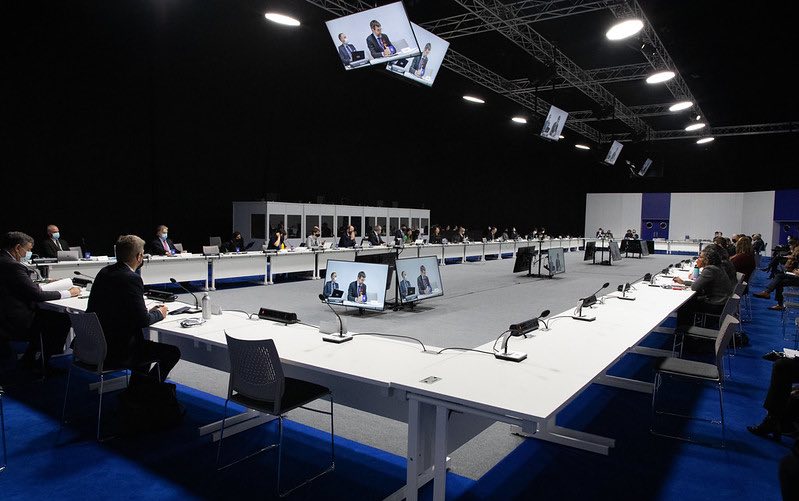Article 2 of the Paris Climate Agreement sets out the principal goals of the pact, including holding the increase in the global average temperature below 2°C above pre-industrial levels and increasing adaptability and resilience. It also establishes the additional purpose of “making finance flows consistent with a pathway towards low greenhouse gas emissions and climate-resilient development.” It is not a surprise then that the topic of climate finance featured prominently in the recent debates during COP26 in Glasgow.
I want to focus on a specific proposal by the Glasgow Financial Alliance for Net Zero (GFANZ), made up of more than 450 banks and other investors across 45 countries that collectively manage about $130 trillion in financial assets. They have pledged to mobilize the estimated $100 trillion in financial investments needed until 2050 to achieve net-zero carbon emissions.
This is a very commendable initiative. But as usual in these cases, it has also been greeted with skepticism by some and generated some confusion. Whether the doubters are right or wrong, time will tell. Here I just want to focus on the confusion by some, as exemplified by a recent Wall Street Journal commentary by Joshua Rauh and Mels de Zeeuw, “Net Zero Will Make Wall Street Richer at Main Street’s Expense.”
The title sounded very interesting. However, there are three common mistakes of finance, timing, and economics that undermine the argument that net zero financing only helps Wall Street while hurting Main Street.
Regarding finance, Messrs. Rauh and de Zeeuw refer to “the $130 trillion in private capital pledged to support the energy transition” which then “can no longer be invested in other productive activities.” This comment confuses stocks and flows—a mistake made by more than one observer. The attention-grabbing number of $130 trillion refers to assets (i.e. a stock variable not a flow variable) of the financial institutions involved. Assets are investment flows that have been already committed and allocated; to that extent, they cannot finance new investments. Even a process of divestiture of financial instruments from climate-negative investments does not change much considering that those financial instruments need to be bought by someone else (balancing the financial flows), while the physical asset (say a coal-fired energy plant) remains the same.
What the institutions are pledging, as previously mentioned, is to mobilize $100 trillion in new finance (a flow) until 2050; i.e., somewhat less than $3.5 trillion per year distributed over almost three decades (about 4% of 2020 global GDP in current dollars and not the 135% mentioned in the WSJ article). The number of $3 trillion-$4 trillion is, not by chance, the estimated annual investments by the International Energy Agency for the energy transition to net zero economies. It is also about the amount that Bank of America’s Brian Moynihan mentioned in another WSJ article, by Greg Ip, as feasible to be mobilized annually, given the right policy frameworks. It is true, though, that allocating $3 trillion-$4 trillion to some investments (out of somewhat more than $23 trillion in annual global savings) implies that other possible activities will not get financed. But that is the usual operation of capital markets, and of economies, in which scarce resources are allocated to alternative uses (more on this below).
Second, Messrs. Rauh and de Zeeuw seem to think that the financing would be happening now (“U.S. households and business will face higher utility prices … This is particularly troubling when many households already face an inflationary pinch …”). It is clear that the transition to net zero is being financed over several decades, and the ups and downs of always volatile energy markets in the short term are irrelevant to the longer-term program of avoiding a potential climate catastrophe. Further, many of the net zero energy technologies are expected to be more stable in terms of costs and prices, helping households and businesses.
Which leads to the third, and probably worst confusion: The authors seem to ignore the well-established economic principle that unpriced externalities—in this case, the multiple impacts of climate change—break the optimal operation of markets. They compare the process of replacing current plants with high levels of greenhouse gas emissions (GHGs) to government mandates “that all machines of certain color, say brown, must be destroyed and replaced with machines of a different color, say green” as if they were the same, except for the color. In fact, they have very different externality costs: Those of continuing to pump GHGs into the atmosphere on the one hand, and substantially lower or no emissions on the other. It should be noted that climate-related externalities are currently not only not internalized in the prices of energy but are in fact subsidized at about $800 billion a year globally, according to a recent IMF analysis (counting only the difference between costs of production and prices paid; with the mispricing of externalities that number is about seven times higher). The elimination of those subsidies is part of the Glasgow Climate Pact, which commits countries to “accelerating efforts towards the phase-down of unabated coal power and inefficient fossil fuel subsidies, recognizing the need for support towards a just transition” (paragraph 36). Phasing those subsidies down (or, better, out), along with a proper pricing of the negative externalities, will provide the market signals to guide the $3 trillion-$4 trillion mentioned before to climate-positive investments.
Messrs. Rauh and de Zeeuw close with an appeal to policy makers and commentators to be realistic about costs and to consider all options for the transition. That is correct. However, all their other arguments reflect common confusions that need to be dispelled.
Eugenio Díaz-Bonilla is Head of IFPRI’s Latin American and Caribbean Program.







